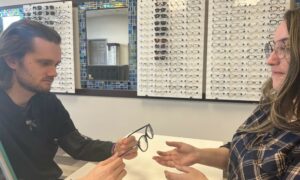By Cheryl G. Murphy, OD

Research shows that blue-violet light can be harmful to our eyes, but how do we bring this up to our patients?
Over the past seven months, I have written articles discussing the dangers that overexposure to blue-violet light can pose on ocular health. Writing a good article starts with good research and you have to thoroughly understand a topic before you try to present it to others, so I set out on a quest to learn all I could about it. I reintroduced myself to the electromagnetic spectrum and reacquainted myself with its various hazards. After digging around in textbooks and reading the latest research articles on Pubmed, I began to understand why blue-violet light is a threat to our eyes and how important it is to begin to tell our patients about this harmful wavelength of visible light.
Reading research is one thing; translating that research into patient education is another. When I first began to tell patients that the visible blue-violet light emitting from their treasured tablet devices, smartphones, energy efficient light bulbs and computer screens may be doing them more harm than good, I received some blank stares, snickers and even a couple of eye rolls. Many people just don’t want to believe that these cool, new gadgets that are whiter, brighter and crisper could be causing their eyes any problems. I soon learned to bring up the subject delicately and with tact so they’d be less likely to tune out my advice completely.
One tip I would give fellow eyecare professionals on how to educate patients on blue-violet light would be: don’t preach. People have adapted these devices into their daily lives and will not give them up. Instead, try to advise them to modify their behavior while using them.
Rules for Using Tablets, Smartphones, Computers and Electronic Devices
1. “Increase the working distance between the device and your eyes.” I often tell patients you should be reading your smartphone while it rests on your lap, not up close like a novel.
2. “Decrease the brightness of these devices to less than half the intensity, or better yet, to as low as you can stand it.” This will lessen the overall amount of blue light emitted.
3. “Use it in moderation.” Our eyes are glued to screens nowadays more than ever before. Technology is great and fun, and it’s awesome to keep in touch, but it shouldn’t rule your life. Take some time to stop and smell the roses, glance at the trees or at the person you are about to bump into on the sidewalk.
4. “Take frequent breaks.” I think we as optometrists are all very good about educating patients on the 20/20/20 rule for computer use, but we have to be sure we are letting them know that it also applies to tablets and smartphones, as well.
If you have a patient who is admittedly bad at complying with these four rules, then consider prescribing them a lens or a lens treatment that selectively filters out some blue-violet light to lessen their cumulative exposure.
Another tip I would give eyecare professionals when it comes to educating patients on blue light is educate yourself first. Consider taking a continuing education course on blue light and reading up on it. You might be surprised how much you have forgotten or how things have changed. You will also learn the latest prescribing options that are at your disposal to help combat overexposure to blue light.
The third and final tip I would give ECPs would be to decide for yourself how and when you would like to begin discussing this with patients. You have to believe in something to prescribe it to your patients with confidence. I think after you acquaint yourself with the hazards of blue-violet light, you will see why today more than ever we need to step up and help our patients defend themselves against the coming decades of blue-violet light exposure to which their eyes will be subjected.
Resources: Further Reading on Blue Light
Balancing the Blues 20/20 magazine Dec 2013
The New Blue: What ECPs need to know about the latest lenses filtering harmful blue light, Vision Monday Sept 2013
10 Products that Block Blue, Vision Monday Sept 2013
What’s your take on blue-violet light? Have you prescribed blue-violet filtering lenses for patients? How have you been successful in educating patients on proper computer ergonomics and blue-violet light? Have you found that the general public has already heard about the dangers of blue-violet light or were you the first to discuss it with them?
Cheryl G. Murphy, OD, practices at an independent optometric practice in Holbrook, NY. You can like her on Facebook or follow her on Twitter @murphyod. To contact her: murphyc2020@gmail.com.

























